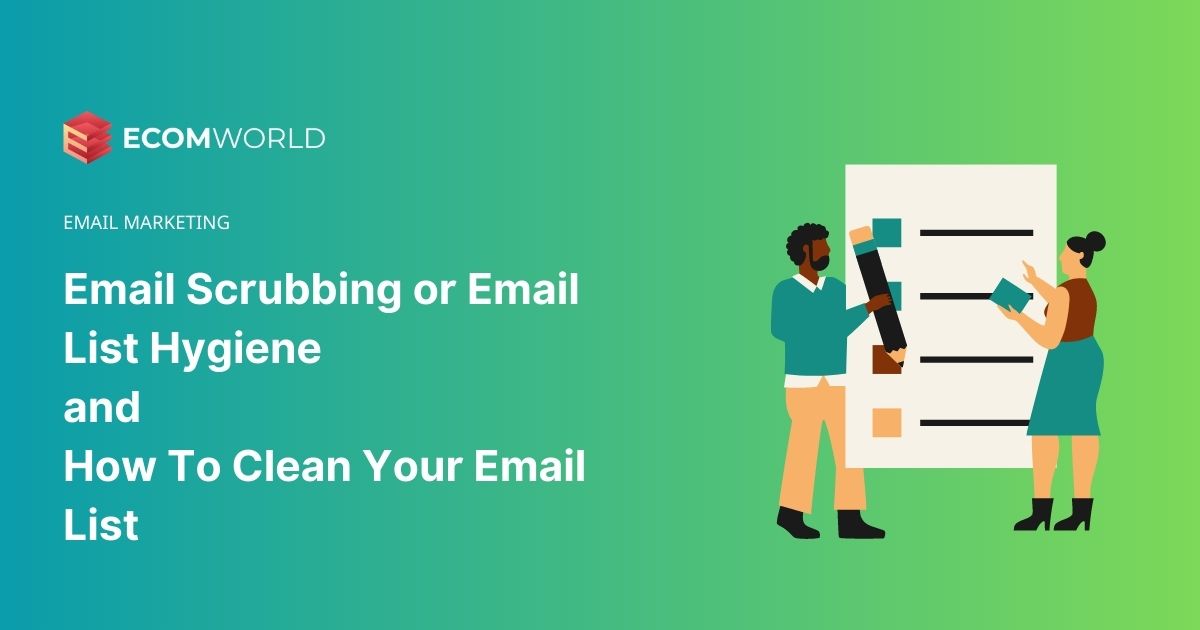Email marketing serves as a potent tool for businesses, regardless of their size, enabling direct and cost-effective communication with their target audience. Nonetheless, the effectiveness of email marketing campaigns heavily relies on the quality of the email list utilized. Outdated, inactive, or invalid email addresses within the list can render these campaigns ineffective, leading to issues such as spam complaints and high bounce rates.
To address this concern, email list hygiene or email scrubbing comes into play. This process involves the removal of inactive, invalid, and unengaged subscribers from the email list, ensuring that only engaged and interested recipients receive the emails. Email scrubbing is an indispensable practice for any business seeking to optimize their email campaigns and achieve the highest level of effectiveness.
In this blog post, we will delve deeper into the concept of email scrubbing, its significance, and the steps involved. Additionally, we will explore the advantages of email scrubbing and offer valuable tips for maintaining a clean and engaged email list. By the end of this post, you will gain a comprehensive understanding of the crucial role email scrubbing plays in the success of email campaigns and how to implement it effectively for your business.
Table of Contents
What is email scrubbing?

Email scrubbing, also referred to as email list cleaning aims to eliminate invalid, inactive, or unresponsive email addresses from a mailing list. The primary objective is to enhance the overall quality of the list and guarantee that emails are sent only to individuals who are likely to interact with them.
The email scrubbing process involves a thorough analysis of the list to identify email addresses that are no longer valid, such as those that have bounced back or are no longer in use. Additionally, it may entail the removal of email addresses that have shown no engagement with previous emails, as these recipients are unlikely to be interested in future messages.
When should you do email scrubbing?

Regular email scrubbing is crucial to preserve the quality of an email list, and the frequency of this practice depends on the size of the list and the rate at which email addresses are added or removed.
Here are some general recommendations for determining when to conduct email scrubbing:
- Quarterly: Large email lists with frequent changes should undergo email scrubbing every quarter to maintain accuracy and relevance.
- Semi-Annually: Medium-sized email lists should be scrubbed every six months to ensure list hygiene.
- Annually: Small email lists with infrequent changes can benefit from email scrubbing once a year to maintain cleanliness and relevance.
Apart from regular email scrubbing, it is essential to perform verification checks whenever new email addresses are added to the list. This ensures the validity and activity of the new addresses and helps prevent the inclusion of invalid or fraudulent email addresses in the list.
5 Benefits of email scrubbing
- Enhanced Open and Click-Through Rates By performing email scrubbing, inactive and unengaged subscribers are removed from the list, leaving behind engaged recipients more likely to open and interact with emails. This results in higher engagement rates, ultimately boosting the overall success of email campaigns.
- Decreased Spam Complaints Email scrubbing effectively reduces the occurrence of spam complaints, as emails are sent only to individuals who have willingly opted to receive them. Maintaining a positive sender reputation and preventing emails from being flagged as spam are significant outcomes of this practice.
- Minimized Bounces Through list scrubbing, the number of email bounces is minimized by eliminating invalid or inactive email addresses. This optimization improves email deliverability, ensuring that emails reach valid recipients.
- Cost Savings The removal of inactive and unengaged subscribers leads to cost savings in email campaigns. By avoiding the delivery of emails to uninterested recipients, businesses can optimize their campaign spending and achieve a higher return on investment (ROI).
- Accurate Reporting Email scrubbing results in more precise metrics and reporting, providing insights into the engagement and performance of active subscribers. These accurate data enable businesses to make data-driven decisions and optimize their email campaigns effectively.
What is the email scrubbing process?

Email scrubbing can be accomplished through various steps. Here are some key components of the email scrubbing process:
Step 1: Identifying Inactive Subscribers Define criteria for identifying inactive subscribers—those who haven’t opened or engaged with emails within a specific timeframe. Establishing clear guidelines is essential before initiating the scrubbing process.
Step 2: Segmentation of Inactive Subscribers Segment the inactive subscribers based on the duration of their disengagement. Tailoring win-back strategies for each group can increase the chances of re-engagement.
Step 3: Removal of Duplicates, Spam, and Misspelled Emails Before proceeding with the scrubbing, eliminate any duplicate, spam, or misspelled emails. This ensures a clean and accurate email list.
Step 4: Executing Win-Back Campaigns For the identified inactive subscribers, design and execute win-back campaigns, offering special promotions or valuable content to re-ignite their interest in future emails.
Step 5: Removal of Inactive Subscribers After the win-back campaign, remove subscribers who remain unengaged. This step maintains list hygiene and prevents inactive subscribers from adversely affecting campaign performance.
In conclusion, email scrubbing is a vital process for maintaining a clean and engaged email list, which is crucial for the success of any email marketing campaign. By eliminating inactive, invalid, and unengaged subscribers, businesses can enhance their email campaign performance, minimize spam complaints and bounces, and optimize their expenditures.
The email scrubbing process involves steps such as defining inactive subscribers, segmenting the list, removing duplicates and misspelled emails, implementing win-back campaigns, and ultimately removing unresponsive subscribers. Regularly scrubbing email lists ensures that emails are sent to engaged and interested recipients, avoiding the negative impact of a poorly maintained list.
Remember, maintaining a clean and engaged email list requires ongoing attention and effort. However, the benefits of email scrubbing far outweigh the investment. It leads to higher engagement rates, improved deliverability, and a higher return on investment (ROI) for email campaigns. Prioritizing email scrubbing can significantly contribute to the success of your business’s email marketing endeavors. So, start implementing it today and reap the rewards of a well-maintained email list.

